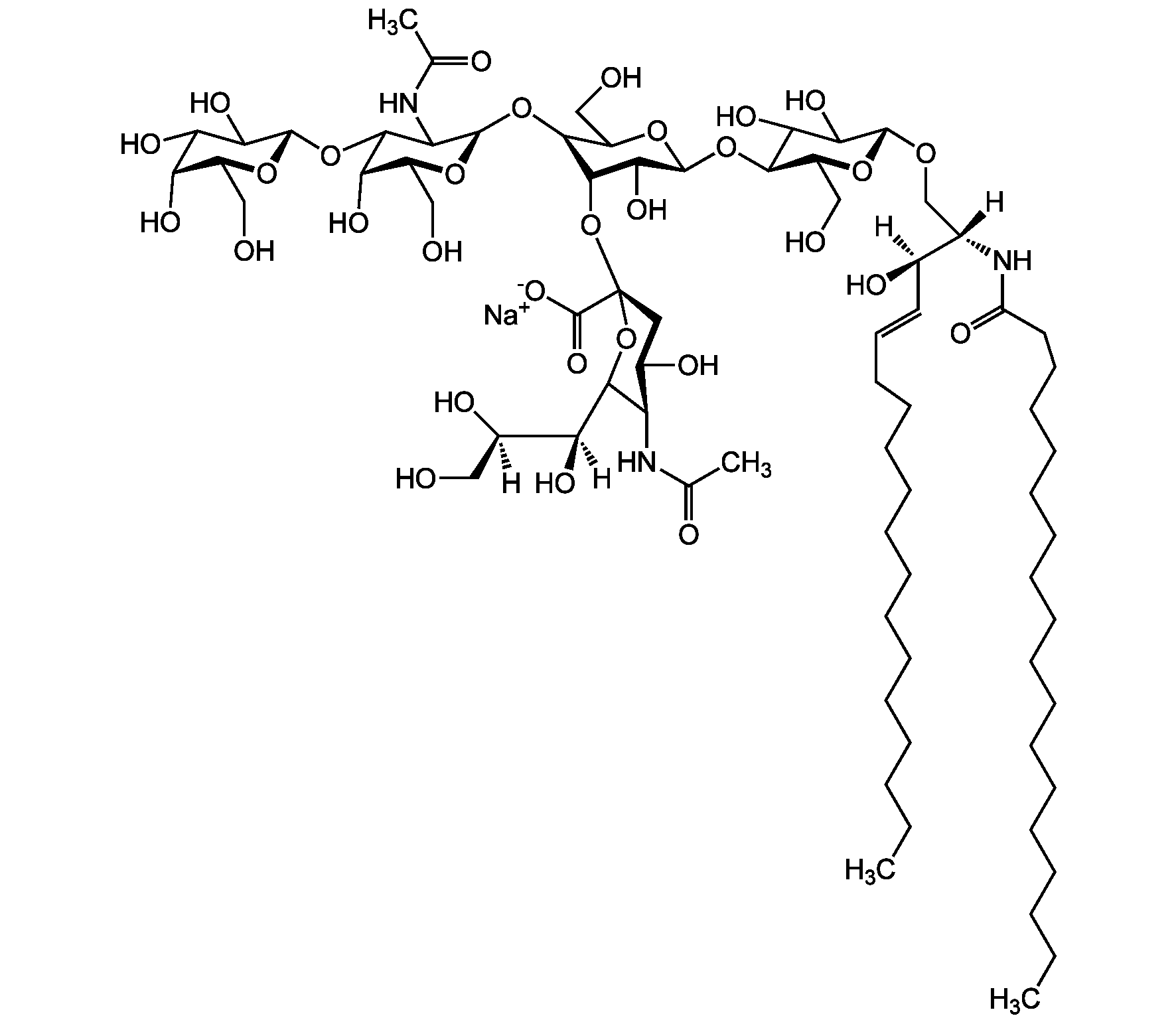
Chemical Structure
Ganglioside GM1 . sodium salt (bovine brain) [37758-47-7]

AG-CN2-9000
CAS Number37758-47-7
Product group Chemicals
Estimated Purity>98%
Molecular Weight1545.8 . 23.0 (calculated on sphingosine C18:1 and stearic acid)
Overview
- SupplierAdipoGen Life Sciences
- Product NameGanglioside GM1 . sodium salt [37758-47-7]
- Delivery Days Customer10
- CAS Number37758-47-7
- CertificationResearch Use Only
- Estimated Purity>98%
- Molecular FormulaC73H130N3O31 . Na
- Molecular Weight1545.8 . 23.0 (calculated on sphingosine C18:1 and stearic acid)
- Scientific DescriptionChemical. CAS: 37758-47-7. Formula: C73H130N3O31 . Na. MW: 1545.8 . 23.0 (calculated on sphingosine C18:1 and stearic acid). Isolated from bovine brain. Gangliosides are acidic glycosphingolipids that form lipid rafts in the outer leaflet of the cell plasma membrane, especially in neuronal cells in the central nervous system. They participate in cellular proliferation, differentiation, adhesion, signal transduction, cell-to-cell interactions, tumorigenesis and metastasis. The accumulation of gangliosides has been linked to several diseases. Ganglioside GM1 is a major sialoglycolipid of neuronal membranes that modulates calcium homeostasis and which is important for neuronal plasticity and repair mechanisms. It binds to cholera toxin B subunit, resulting in stimulation of adenylyl cyclase in a wide variety of cell types. After cholera toxin binds to membrane associated Monosialoganglioside GM1, the A subunit of cholera toxin is translocated to the cell interior, where it catalyzes the ADP ribosylation of the membrane associated Gs subunit of adenylyl cyclase. In addition, binding of cholera toxin to monosialoganglioside GM1 causes translocation of NF-kappaB and activation of dendritic cells. E. coli heat-labile enterotoxin (LT) is structurally and functionally similar to cholera toxin and binds GM1 as well. GM1 has also been shown to improve Parkinsons disease symptoms and slow its progression. - Gangliosides are acidic glycosphingolipids that form lipid rafts in the outer leaflet of the cell plasma membrane, especially in neuronal cells in the central nervous system. They participate in cellular proliferation, differentiation, adhesion, signal transduction, cell-to-cell interactions, tumorigenesis and metastasis. The accumulation of gangliosides has been linked to several diseases. Ganglioside GM1 is a major sialoglycolipid of neuronal membranes that modulates calcium homeostasis and which is important for neuronal plasticity and repair mechanisms. It binds to cholera toxin B subunit, resulting in stimulation of adenylyl cyclase in a wide variety of cell types. After cholera toxin binds to membrane associated Monosialoganglioside GM1, the A subunit of cholera toxin is translocated to the cell interior, where it catalyzes the ADP ribosylation of the membrane associated Gs subunit of adenylyl cyclase. In addition, binding of cholera toxin to monosialoganglioside GM1 causes translocation of NF-kappaB and activation of dendritic cells. E. coli heat-labile enterotoxin (LT) is structurally and functionally similar to cholera toxin and binds GM1 as well. GM1 has also been shown to improve Parkinsons disease symptoms and slow its progression.
- SMILES[Na+].[H][C@@](O)(CO)[C@]([H])(O)C1O[C@@](CC(O)[C@H]1NC(C)=O)(O[C@@H]1C(O)[C@H](O[C@H]2C(O)C(O)[C@H](OC[C@]([H])(NC(=O)CCCCCCCCCCCCCCCCC)[C@]([H])(O)\C=C\CCCCCCCCCCCCC)O[C@H]2CO)OC(CO)[C@@H]1O[C@H]1O[C@@H](CO)[C@H](O)C(O[C@@H]2O[C@@H](CO)[C@H](O)C(O)C2O)C1NC(C)=O)C([O-])=O
- Storage Instruction-20°C,2°C to 8°C
- UNSPSC12352200
References
- Role of membrane gangliosides in the binding and action of bacterial toxins: P.H. Fishman; J. Membr. Biol. 69, 85 (1982)
- Promotion of neuritogenesis in mouse neuroblastoma cells by exogenous gangliosides. Relationship between the effects and the cells association of ganglioside GM1: L. Facci, et al.; J. Neurochem. 42, 299 (1984)
- A bacterium lipopolysaccharide that elicits Guillain-Barré syndrome has a GM1 ganglioside-like structure: N.Yuki, et al.; J. Exp. Med. 178, 1771 (1993)
- Ganglioside GM1 binds to the Trk protein and regulates receptor function: T. Mutoh, et al.; PNAS 92, 5087 (1995)
- Dynamic and structural properties of sphingolipids as driving force to the formation of membrane domains: S. Sonnino, et al.; Chem. Rev. 106, 2111 (2006)
- GM1 ganglioside in Parkinson's disease: Results of a five year open study: J.S. Schneider, et al.; J. Neurol. Sci. 292, 45 (2010)
- Heat-Labile Enterotoxin: Beyond GM1 Binding: B. Mudrak & M.J. Kuehn; Toxins 2, 1445 (2010)
- New findings on nuclear gangliosides: overview on metabolism and function: R. Ledeen & G.Wu; J. Neurochem. 116, 714 (2011)
- Binding of CFA/I pili of enterotoxigenic Escherichia coli to Asialo-GM1 is mediated by the minor pilin CfaE: T.P. Madhavan, et al.; Infect. Immun. 84, 1642 (2016)
- Phenotypic Analysis Reveals that the 2010 Haiti Cholera Epidemic Is Linked to a Hypervirulent Strain: K.J.F. Satchell, et al.; Infect. Immun. 84, 2473 (2016)
